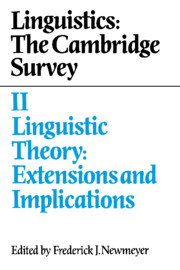Book contents
- Frontmatter
- Contents
- Contributors
- Preface
- 1 Extensions and implications of linguistic theory: an overview
- 2 Grammar and language processing
- 3 Grammatical principles of first language acquisition: theory and evidence
- 4 Second language acquisition and grammatical theory
- 5 Brain structures and linguistic capacity
- 6 Abnormal language acquisition and the modularity of language
- 7 Grammatical aspects of speech errors
- 8 Grammar and conversational principles
- 9 Discourse analysis: a part of the study of linguistic competence
- 10 Speech act distinctions in grammar
- 11 Computer applications of linguistic theory
- 12 Metrics and phonological theory
- 13 Grammatical theory and signed languages
- 14 The linguistic status of creole languages: two perspectives
- 14.I Creole languages and the bioprogram
- 14.II Are creoles a special type of language?
- 14.III A dialog concerning the linguistic status of creole languages
- Subject index
- Name index
- Contents of volumes I, III, and IV
11 - Computer applications of linguistic theory
Published online by Cambridge University Press: 08 February 2010
- Frontmatter
- Contents
- Contributors
- Preface
- 1 Extensions and implications of linguistic theory: an overview
- 2 Grammar and language processing
- 3 Grammatical principles of first language acquisition: theory and evidence
- 4 Second language acquisition and grammatical theory
- 5 Brain structures and linguistic capacity
- 6 Abnormal language acquisition and the modularity of language
- 7 Grammatical aspects of speech errors
- 8 Grammar and conversational principles
- 9 Discourse analysis: a part of the study of linguistic competence
- 10 Speech act distinctions in grammar
- 11 Computer applications of linguistic theory
- 12 Metrics and phonological theory
- 13 Grammatical theory and signed languages
- 14 The linguistic status of creole languages: two perspectives
- 14.I Creole languages and the bioprogram
- 14.II Are creoles a special type of language?
- 14.III A dialog concerning the linguistic status of creole languages
- Subject index
- Name index
- Contents of volumes I, III, and IV
Summary
Fact and fiction
Computers that use language proficiently are commonplace in works of fiction and in people's fantasies about technology. Computers traffic in information, and language is the most powerful vehicle for the communication of information. Language is an integral part of our culture, of our psychology, and (some claim) of our genetic constitution. Therefore, when we think about communication, whether among people, among people and machines, or among machines networked together, it is difficult to not also think of language. In a sense, there is a good basis for this association. Programs are statements in a linguistic system. This is the case whether they are applications programs, or the programs that constitute the operating system controlling the shunting of information between different parts of the machine (disk, memory, processor), or the communications software that controls the exchange of information between computers connected together. But in talking about both computers and people as using language we also introduce the possibility of a confusing equivocation which invites the conclusion that the differences between these linguistic systems are superficial, while, in fact, they are profound. A computer language is not just a different language in the sense that French is a language different from English. Had that been the case, the linguistic skills of modern computers would, undoubtedly, be much closer to the fictional fantasies of Karel Čapek's RUR (Rossum's Universal Robot) (Čapek 1920) or the (in)famous HAL in ‘2001: A Space Odyssey’.
Natural languages and computer languages differ in a number of ways which we are just beginning to understand now that systematic investigations of the relationship between the two are getting under way.
- Type
- Chapter
- Information
- Linguistics: The Cambridge Survey , pp. 198 - 219Publisher: Cambridge University PressPrint publication year: 1988



